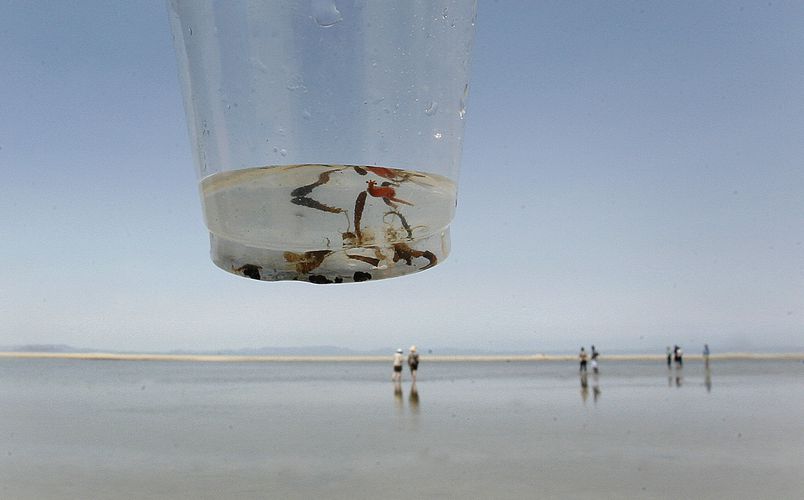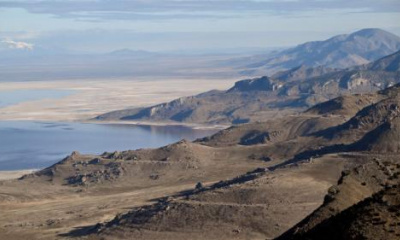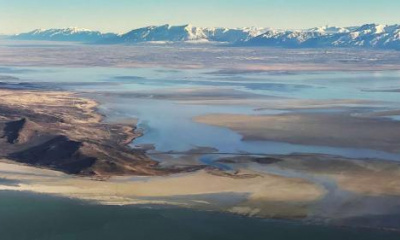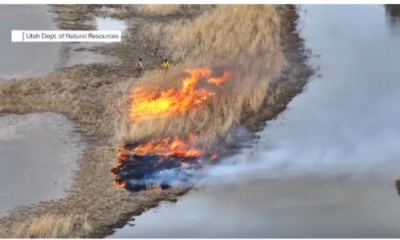Scientists note changes to the food web they’ve never seen before, which could lead to endangered species listings and other disasters at Utah’s famous natural wonder.
As the Great Salt Lake continues to shrink to unprecedented levels, a key component of its landscape and food web is missing.
The lake is known for thick, black clusters of brine flies by the billions, which pupate in its salty water then gather in dense mats to reproduce on shore. The insectile masses occasionally gross out beachgoers, but the bugs are harmless to humans. Crucially, they provide a nutrient-rich feast for millions of migrating birds. This year, however, the fly swarms are gone. And something’s off about the few bugs that remain.
Scientists say it’s a sign the lake’s ecological demise is here.
“We don’t have clouds of flies around our ankles anymore,” biology professor Bonnie Baxter, who helms Westminster College’s Great Salt Lake Institute, told a group of researchers and lake-based industry experts late last month. “The flies don’t look right. They’re small. They’re behaving funny.”
Brine flies and brine shrimp are saline lakes’ most unique and charismatic endemic critters. They draw more than 10 million migrating shorebirds and waterfowl to the Great Salt Lake every year, from phalaropes to ducks to gulls to avocets. Now, the fly food web is all but gone, and things aren’t looking good for the shrimp, either.
“It’s not like we’ve got a thousand different food chains,” Baxter said in an interview. “There’s two with these two keystone species.”
And all indicators point to those food chains collapsing, Baxter said.
A crisis situation
She recently tapped one of the nation’s top brine fly researchers, biologist David Herbst, to conduct a field reconnaissance of the lake and help Westminster College develop a program to better monitor the flies. Herbst is affiliated with the University of California Sierra Nevada Aquatic Research Laboratory.
He has conducted research at saline lakes throughout the Great Basin, contributing to some of the first studies that shed light on the impending disaster that faced Mono Lake in the 1970s.
“Even though it’s in a crisis situation,” Herbst said in an interview about his visit to the Great Salt Lake, “it’s really good people are starting to pay attention.”
Brine flies are facing stressors from multiple fronts, Herbst explained. The flies need a rocky substrate to attach to underwater as they metamorphosize from pupae to adults. At Mono Lake, they latch on to tufa. At the Great Salt Lake, they use rocky structures formed by bacterial mats called microbialites.
But many of the lake’s microbialites have surfaced, killing the microorganisms that form them along with food for the flies. And the structures that remain underwater are still too close to the surface, causing wave action to knock the juvenile insects loose. In their field trip last month in search of the formerly bountiful brine flies, Baxter and Herbst only found about a half-dozen adults.
“I would expect to see much greater abundance of adult flies and pupae” at the lake this time of year, Herbst said, adding his impression of the ecosystem is one “that’s suffered some great losses.”
The lake has lost so much water — and concentrated so much of its salts — that the bugs are also having a hard time regulating the salinity levels in their blood. That leads to smaller adults, which lay fewer eggs.
“Bottom line, from my observations,” Herbst said, “... it looks like they’re surviving but not thriving.”
‘We’ve hit that point. We’re seeing impacts.’
The Utah Division of Wildlife has loads of data on the Great Salt Lake’s brine shrimp because it has a viable shrimp harvesting industry that pays for research. But far less is known about the lake’s brine flies, conceded John Luft, director of DWR’s Great Salt Lake Ecosystem Program.
“It’s not something we actively have been collecting like we have for brine shrimp,” Luft said, “since the commercial fishery is the main source of income and funding for our program.”
In his regular field reconnaissance across the lake, however, Luft said one thing is obvious: “We’ve seen a significant decrease in brine fly populations.”
That’s concerning because while a lot of birds depend on the lake’s brine shrimp to survive — including 5 million eared grebe — a lot more flocks rely on the flies. Common goldeneye dive down the water column and gobble up all the pupae attached to microbialite structures. Phalaropes pick at the bugs that float to the surface. Gulls run across beaches, mouths open wide, and gorge on the throngs of adults covering the shoreline.
And with all those flies gone, it’s clear the birds will starve.
“I don’t know that I want everybody thinking that once you go over this cliff that there is no recovery,” Luft said, “but I think we’ve hit that point. We’re seeing impacts.”
But the collapse hasn’t been sudden or surprising — scientists like Luft and Baxter warned about it long before the lake hit its current record low.
“First it’s the [loss of] habitat, and we’ve been noticing that for years because of lack of water,” Luft said. “Then the next thing was loss of microbialites. The next thing was going to be the brine flies. We’re seeing that. I’ve seen the number of birds drop, too.”
Brine shrimp are the final harbinger of the lake’s ecological demise. And while the commercial shrimpers are seeing an average harvest this season, Luft said that resource might not make it another year unless something changes.
“The adults now are struggling” from high salinity, Luft said. “They are not producing.”
Is the Great Salt Lake beyond saving?
Utah lawmakers took big steps in recent years to help the imperiled lake. During the last general session, they set aside $40 million to improve habitat and secure more water for the Great Salt Lake, which would be 11 feet higher if not for human water consumption according to state-sponsored research. Last month, House Speaker Brad Wilson announced two water districts were going to send 30,000 acre-feet to the lake by the end of the year.
That’s ultimately a drop in the bucket — the Great Salt Lake needs around 2 million acre-feet to reach a sustainable level.
But all the political discussions about the lake and efforts to secure its survival signal a big shift in tone, Luft noted.
“A decade ago when I was complaining that people needed to pay attention to this,” he said, “I’d get the brush-off.”
Herbst’s experience has shown that even when saline lake systems shrink to catastrophic levels, they can bounce back. He pointed to Owens Lake in California, which was drained to unhealthy dust when the city of Los Angeles diverted away its tributaries.
Although it’s often pointed to as a cautionary tale by Great Salt Lake advocates, and sometimes called a “dead lake,” Herbst noted that’s not the case — brine flies and birds survived at Owens Lake’s margins, thanks to seeps and springs. And when L.A. began to rehabilitate the environmental disaster, flooding it with water once again, the shrimp, bugs and birds returned.
“The hopeful message is we can recover these places, we can restore these places,” Herbst said. “They’re not a lost cause.”
But some lake advocates worry about what might be lost while the lake resuscitates. Lynn de Freitas, executive director of FRIENDS of Great Salt Lake, compared it to neglecting one’s health until hit with a heart attack.
“Denial is easy,” de Freitas said. “But the outcome of that is tragic.”
She expressed exasperation at lake-based mineral industries trying to get approval to extend canals and siphon away more water from the lake, even as it appears to be hemorrhaging. And if Utah’s policymakers and water users manage to find a way to make the lake rise again, it faces major consequences now, including endangered species listings and toxic dust storms.
“To what extent have you lost a lot of important muscle tissue of your heart because you waited,” de Freitas said, “because you didn’t pay attention to the signs that were informing you that something’s wrong?”
Baxter, who studies the microorganisms that form the foundation of the lake’s ecology, said lab studies show microbialites can rebound as long as they don’t go “too long” without water, which means the flies and shrimp might rebound, too.
“That is assuming we can get water to the lake in a short period of time,” Baxter said. “I’m optimistic, but moving water to the lake is not something scientists can do.”








